BUS 201: Comprehensive Risk Management Analysis for Airbus Group
VerifiedAdded on 2020/01/07
|10
|1995
|236
Report
AI Summary
This report provides a comprehensive analysis of the Airbus Group's risk management practices, focusing on the application of the COSO Enterprise Risk Management (ERM) framework. It identifies key risks, including fuel, competition, financial, and governmental risks, and examines the current management strategies employed by Airbus. The report delves into risk identification, quantification, and the use of risk registers to assess potential impacts. Furthermore, it explores risk responses, categorizing them into avoidance, transfer, acceptance, reduction, and contingency plans. The analysis highlights the importance of ERM in the aviation industry, emphasizing its role in strengthening decision-making and improving business outcomes. The report concludes by underscoring the significance of proactive risk management for Airbus's continued success, particularly in a dynamic and challenging industry environment.
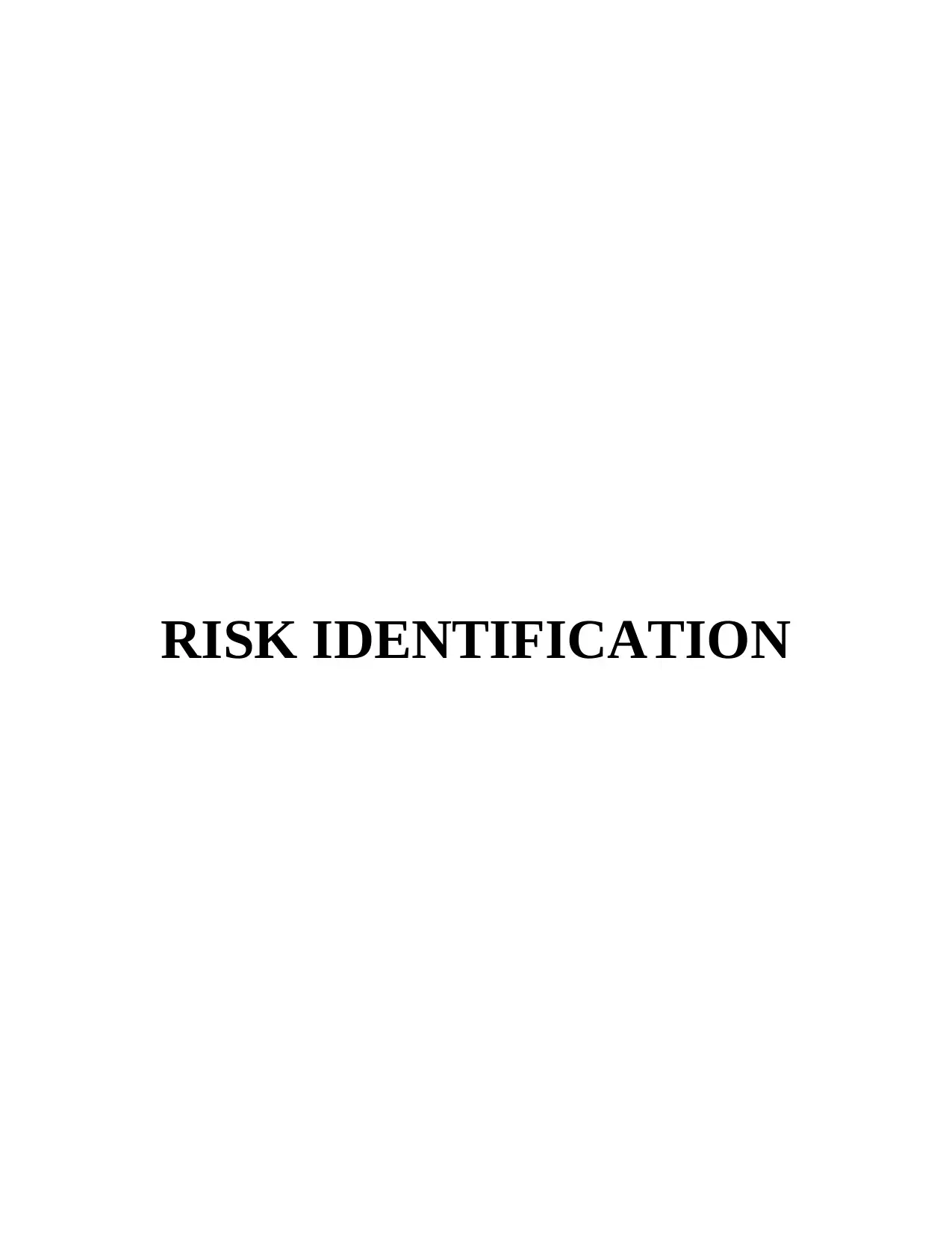
RISK IDENTIFICATION
Paraphrase This Document
Need a fresh take? Get an instant paraphrase of this document with our AI Paraphraser
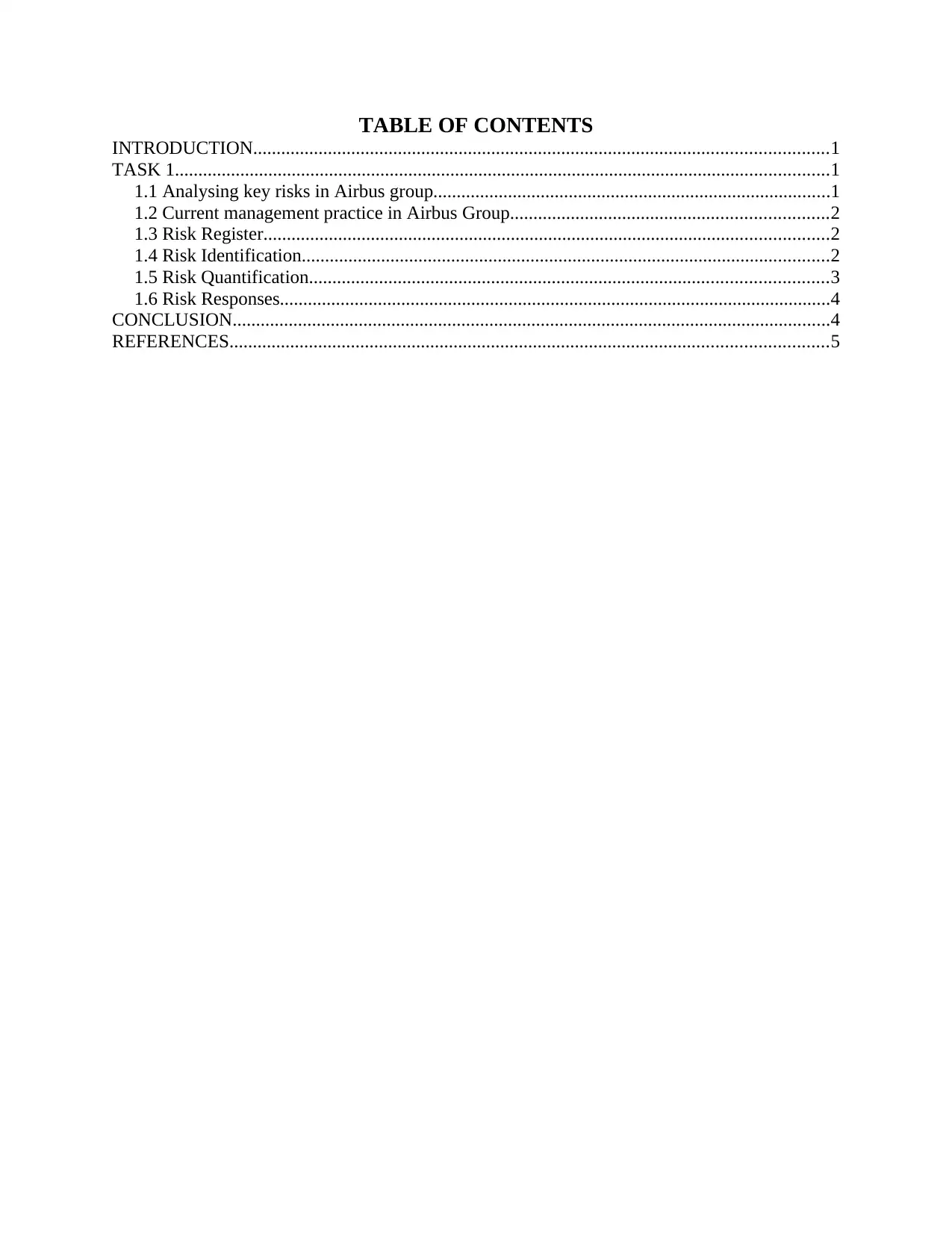
TABLE OF CONTENTS
INTRODUCTION...........................................................................................................................1
TASK 1............................................................................................................................................1
1.1 Analysing key risks in Airbus group.....................................................................................1
1.2 Current management practice in Airbus Group....................................................................2
1.3 Risk Register.........................................................................................................................2
1.4 Risk Identification.................................................................................................................2
1.5 Risk Quantification...............................................................................................................3
1.6 Risk Responses......................................................................................................................4
CONCLUSION................................................................................................................................4
REFERENCES................................................................................................................................5
INTRODUCTION...........................................................................................................................1
TASK 1............................................................................................................................................1
1.1 Analysing key risks in Airbus group.....................................................................................1
1.2 Current management practice in Airbus Group....................................................................2
1.3 Risk Register.........................................................................................................................2
1.4 Risk Identification.................................................................................................................2
1.5 Risk Quantification...............................................................................................................3
1.6 Risk Responses......................................................................................................................4
CONCLUSION................................................................................................................................4
REFERENCES................................................................................................................................5
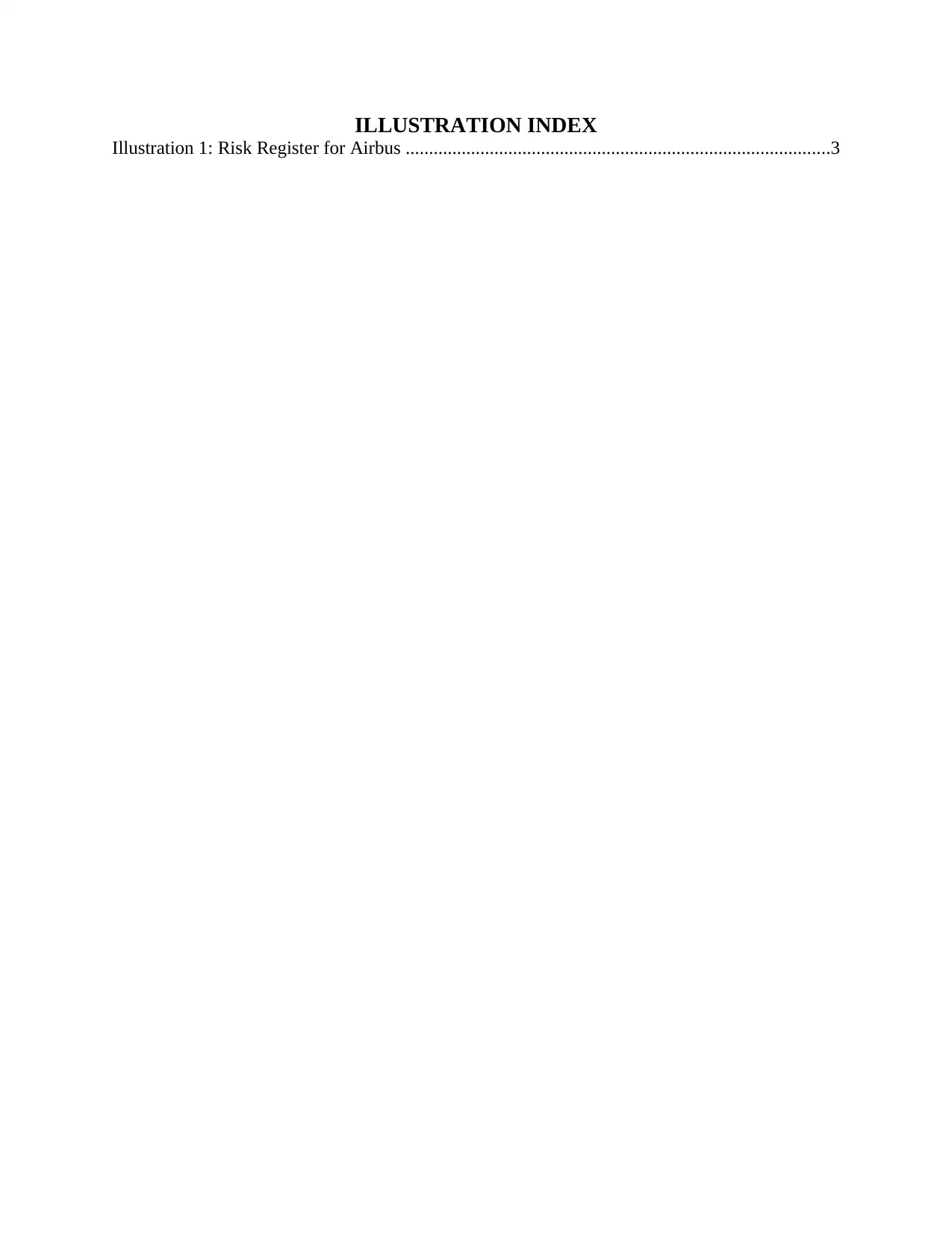
ILLUSTRATION INDEX
Illustration 1: Risk Register for Airbus ...........................................................................................3
Illustration 1: Risk Register for Airbus ...........................................................................................3
⊘ This is a preview!⊘
Do you want full access?
Subscribe today to unlock all pages.

Trusted by 1+ million students worldwide

INTRODUCTION
Enterprise Risk Management is a method to manage risks related to a business. It is a
framework that helps in risk management and includes all those events which can affect the
organisation. The likelihood and impact of the risk is analysed. Along with this, a proper strategy
for response and monitoring process are implemented. The research report contains risk analysis
of Airbus Group which is using COSO Enterprise Risk Management framework to manage
various risks within the organisation. COSO ERM has helped Airbus group in building an
effective risk management network to assess the risk and to strengthen the decision making
process.
TASK 1
1.1 Analysing key risks in Airbus group
Airbus is a leader in aviation industry and it has to face lot of risks and challenges. It is
for the same reason that Airbus has adopted COSO and Active risk manager to deal with the
risks that may arise in the course of its business. The key risks that are associated with the Airbus
group are:
Fuel risks
Competition risks
Adequate liquidity, credit availability and Currency fluctuation
IT failure
government regulations
Economic conditions
Aircraft accidents and Terrorist events
Collective bargaining agreements by labours
Factors that are beyond the control of the company : increase costs, delays, traffic
congestion, unfavourable weather conditions and security measures.
Ineffective management
Financial risks
Hedging risks
Credit control risks
1
Enterprise Risk Management is a method to manage risks related to a business. It is a
framework that helps in risk management and includes all those events which can affect the
organisation. The likelihood and impact of the risk is analysed. Along with this, a proper strategy
for response and monitoring process are implemented. The research report contains risk analysis
of Airbus Group which is using COSO Enterprise Risk Management framework to manage
various risks within the organisation. COSO ERM has helped Airbus group in building an
effective risk management network to assess the risk and to strengthen the decision making
process.
TASK 1
1.1 Analysing key risks in Airbus group
Airbus is a leader in aviation industry and it has to face lot of risks and challenges. It is
for the same reason that Airbus has adopted COSO and Active risk manager to deal with the
risks that may arise in the course of its business. The key risks that are associated with the Airbus
group are:
Fuel risks
Competition risks
Adequate liquidity, credit availability and Currency fluctuation
IT failure
government regulations
Economic conditions
Aircraft accidents and Terrorist events
Collective bargaining agreements by labours
Factors that are beyond the control of the company : increase costs, delays, traffic
congestion, unfavourable weather conditions and security measures.
Ineffective management
Financial risks
Hedging risks
Credit control risks
1
Paraphrase This Document
Need a fresh take? Get an instant paraphrase of this document with our AI Paraphraser
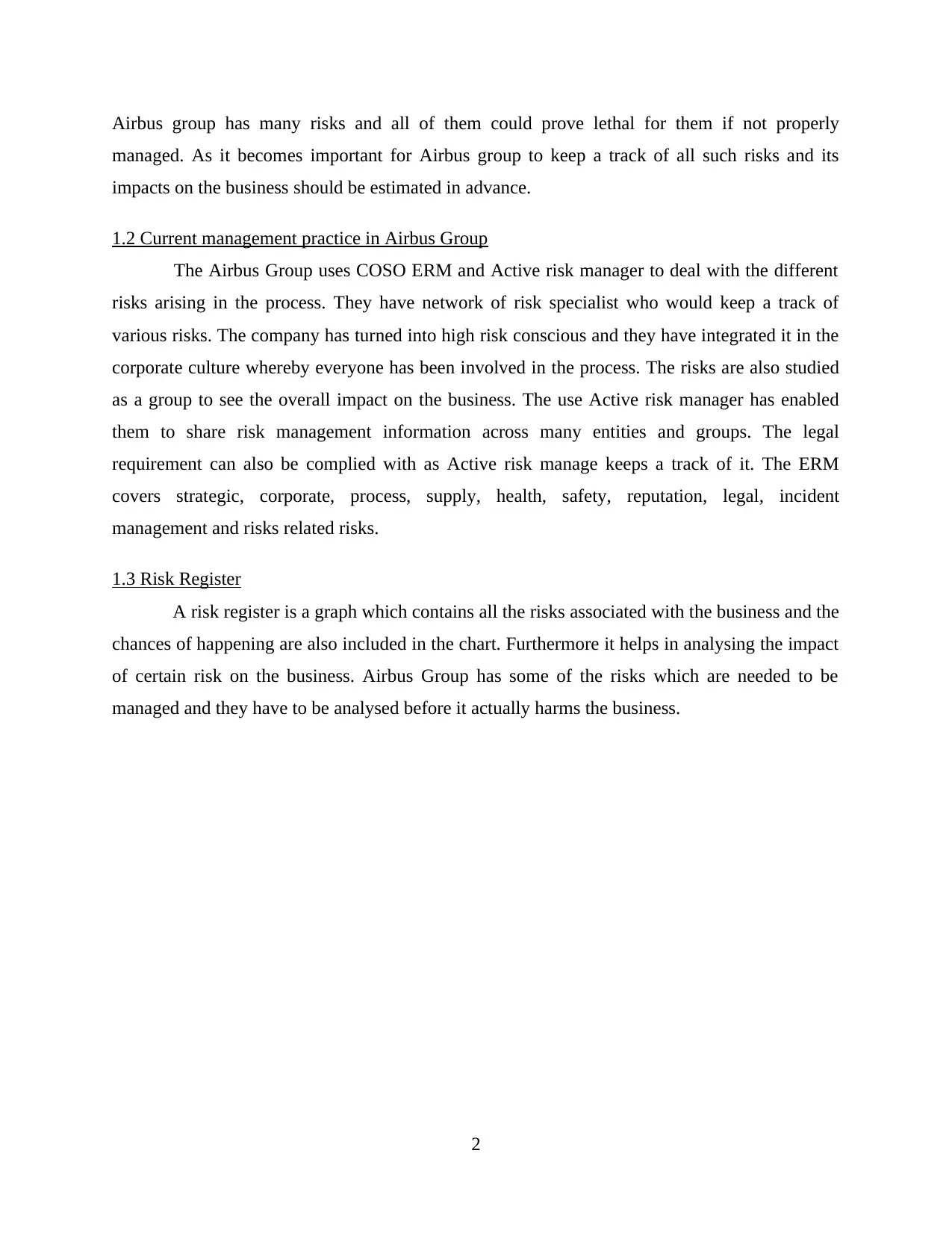
Airbus group has many risks and all of them could prove lethal for them if not properly
managed. As it becomes important for Airbus group to keep a track of all such risks and its
impacts on the business should be estimated in advance.
1.2 Current management practice in Airbus Group
The Airbus Group uses COSO ERM and Active risk manager to deal with the different
risks arising in the process. They have network of risk specialist who would keep a track of
various risks. The company has turned into high risk conscious and they have integrated it in the
corporate culture whereby everyone has been involved in the process. The risks are also studied
as a group to see the overall impact on the business. The use Active risk manager has enabled
them to share risk management information across many entities and groups. The legal
requirement can also be complied with as Active risk manage keeps a track of it. The ERM
covers strategic, corporate, process, supply, health, safety, reputation, legal, incident
management and risks related risks.
1.3 Risk Register
A risk register is a graph which contains all the risks associated with the business and the
chances of happening are also included in the chart. Furthermore it helps in analysing the impact
of certain risk on the business. Airbus Group has some of the risks which are needed to be
managed and they have to be analysed before it actually harms the business.
2
managed. As it becomes important for Airbus group to keep a track of all such risks and its
impacts on the business should be estimated in advance.
1.2 Current management practice in Airbus Group
The Airbus Group uses COSO ERM and Active risk manager to deal with the different
risks arising in the process. They have network of risk specialist who would keep a track of
various risks. The company has turned into high risk conscious and they have integrated it in the
corporate culture whereby everyone has been involved in the process. The risks are also studied
as a group to see the overall impact on the business. The use Active risk manager has enabled
them to share risk management information across many entities and groups. The legal
requirement can also be complied with as Active risk manage keeps a track of it. The ERM
covers strategic, corporate, process, supply, health, safety, reputation, legal, incident
management and risks related risks.
1.3 Risk Register
A risk register is a graph which contains all the risks associated with the business and the
chances of happening are also included in the chart. Furthermore it helps in analysing the impact
of certain risk on the business. Airbus Group has some of the risks which are needed to be
managed and they have to be analysed before it actually harms the business.
2
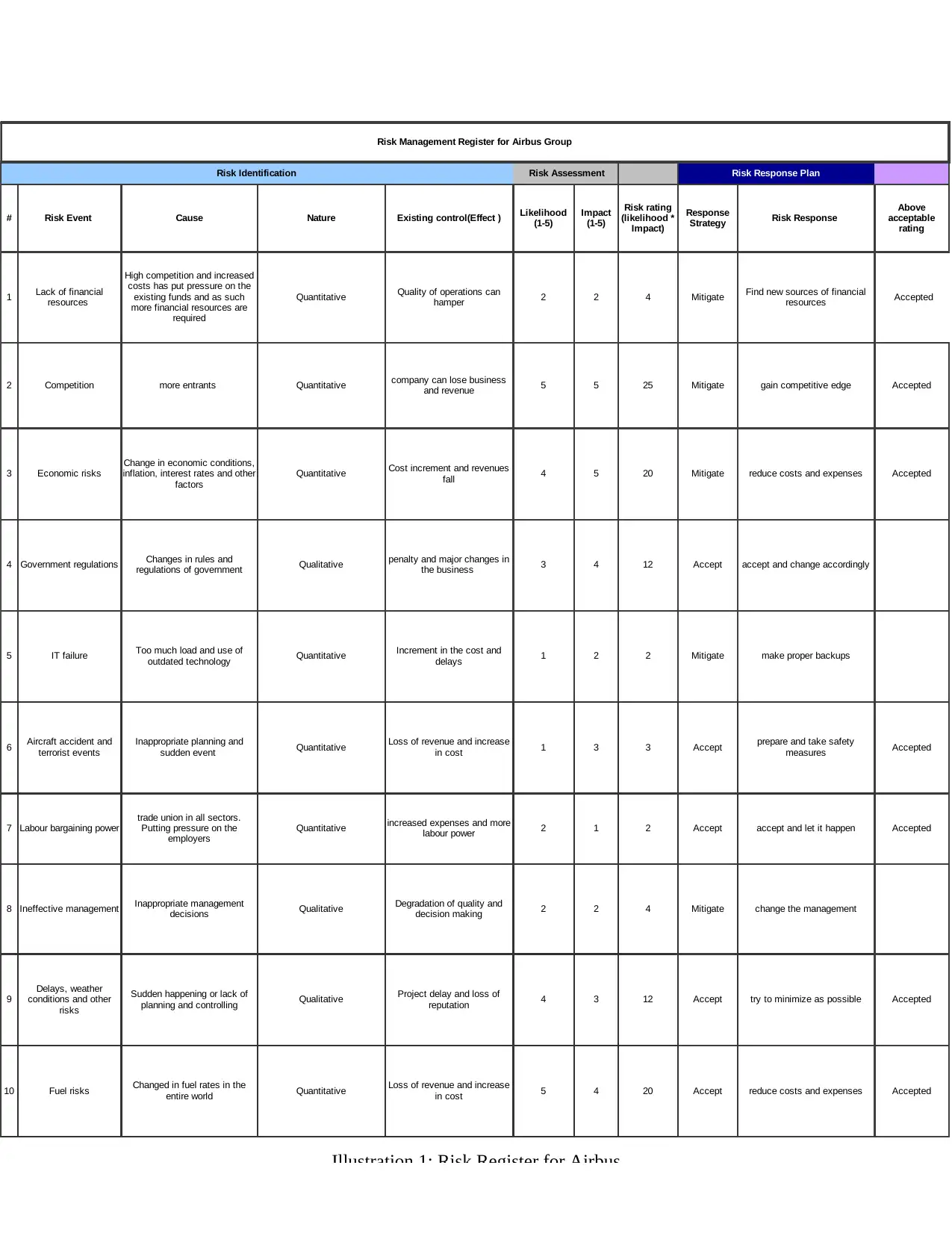
3
Risk Management Register for Airbus Group
Risk Identification Risk Assessment Risk Response Plan
# Risk Event Cause Nature Existing control(Effect ) Risk Response
1 Quantitative 2 2 4 Mitigate Accepted
2 Competition more entrants Quantitative 5 5 25 Mitigate gain competitive edge Accepted
3 Economic risks Quantitative 4 5 20 Mitigate reduce costs and expenses Accepted
4 Government regulations Qualitative 3 4 12 Accept accept and change accordingly
5 IT failure Quantitative 1 2 2 Mitigate make proper backups
6 Quantitative 1 3 3 Accept Accepted
7 Labour bargaining power Quantitative 2 1 2 Accept accept and let it happen Accepted
8 Ineffective management Qualitative 2 2 4 Mitigate change the management
9 Qualitative 4 3 12 Accept try to minimize as possible Accepted
10 Fuel risks Quantitative 5 4 20 Accept reduce costs and expenses Accepted
Likelihood
(1-5)
Impact
(1-5)
Risk rating
(likelihood *
Impact)
Response
Strategy
Above
acceptable
rating
Lack of financial
resources
High competition and increased
costs has put pressure on the
existing funds and as such
more financial resources are
required
Quality of operations can
hamper
Find new sources of financial
resources
company can lose business
and revenue
Change in economic conditions,
inflation, interest rates and other
factors
Cost increment and revenues
fall
Changes in rules and
regulations of government
penalty and major changes in
the business
Too much load and use of
outdated technology
Increment in the cost and
delays
Aircraft accident and
terrorist events
Inappropriate planning and
sudden event
Loss of revenue and increase
in cost
prepare and take safety
measures
trade union in all sectors.
Putting pressure on the
employers
increased expenses and more
labour power
Inappropriate management
decisions
Degradation of quality and
decision making
Delays, weather
conditions and other
risks
Sudden happening or lack of
planning and controlling
Project delay and loss of
reputation
Changed in fuel rates in the
entire world
Loss of revenue and increase
in cost
Illustration 1: Risk Register for Airbus
Risk Management Register for Airbus Group
Risk Identification Risk Assessment Risk Response Plan
# Risk Event Cause Nature Existing control(Effect ) Risk Response
1 Quantitative 2 2 4 Mitigate Accepted
2 Competition more entrants Quantitative 5 5 25 Mitigate gain competitive edge Accepted
3 Economic risks Quantitative 4 5 20 Mitigate reduce costs and expenses Accepted
4 Government regulations Qualitative 3 4 12 Accept accept and change accordingly
5 IT failure Quantitative 1 2 2 Mitigate make proper backups
6 Quantitative 1 3 3 Accept Accepted
7 Labour bargaining power Quantitative 2 1 2 Accept accept and let it happen Accepted
8 Ineffective management Qualitative 2 2 4 Mitigate change the management
9 Qualitative 4 3 12 Accept try to minimize as possible Accepted
10 Fuel risks Quantitative 5 4 20 Accept reduce costs and expenses Accepted
Likelihood
(1-5)
Impact
(1-5)
Risk rating
(likelihood *
Impact)
Response
Strategy
Above
acceptable
rating
Lack of financial
resources
High competition and increased
costs has put pressure on the
existing funds and as such
more financial resources are
required
Quality of operations can
hamper
Find new sources of financial
resources
company can lose business
and revenue
Change in economic conditions,
inflation, interest rates and other
factors
Cost increment and revenues
fall
Changes in rules and
regulations of government
penalty and major changes in
the business
Too much load and use of
outdated technology
Increment in the cost and
delays
Aircraft accident and
terrorist events
Inappropriate planning and
sudden event
Loss of revenue and increase
in cost
prepare and take safety
measures
trade union in all sectors.
Putting pressure on the
employers
increased expenses and more
labour power
Inappropriate management
decisions
Degradation of quality and
decision making
Delays, weather
conditions and other
risks
Sudden happening or lack of
planning and controlling
Project delay and loss of
reputation
Changed in fuel rates in the
entire world
Loss of revenue and increase
in cost
Illustration 1: Risk Register for Airbus
⊘ This is a preview!⊘
Do you want full access?
Subscribe today to unlock all pages.

Trusted by 1+ million students worldwide
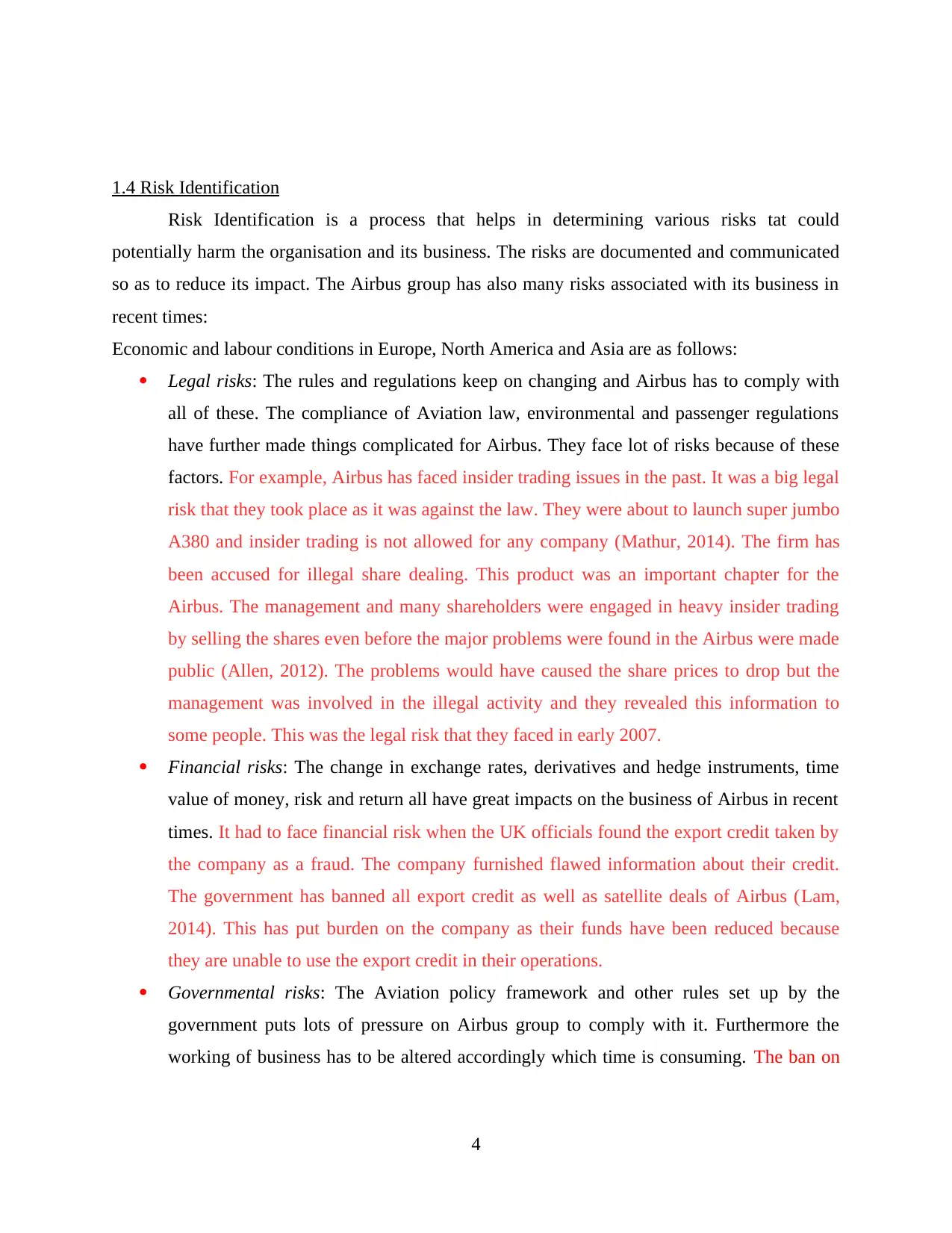
1.4 Risk Identification
Risk Identification is a process that helps in determining various risks tat could
potentially harm the organisation and its business. The risks are documented and communicated
so as to reduce its impact. The Airbus group has also many risks associated with its business in
recent times:
Economic and labour conditions in Europe, North America and Asia are as follows:
Legal risks: The rules and regulations keep on changing and Airbus has to comply with
all of these. The compliance of Aviation law, environmental and passenger regulations
have further made things complicated for Airbus. They face lot of risks because of these
factors. For example, Airbus has faced insider trading issues in the past. It was a big legal
risk that they took place as it was against the law. They were about to launch super jumbo
A380 and insider trading is not allowed for any company (Mathur, 2014). The firm has
been accused for illegal share dealing. This product was an important chapter for the
Airbus. The management and many shareholders were engaged in heavy insider trading
by selling the shares even before the major problems were found in the Airbus were made
public (Allen, 2012). The problems would have caused the share prices to drop but the
management was involved in the illegal activity and they revealed this information to
some people. This was the legal risk that they faced in early 2007.
Financial risks: The change in exchange rates, derivatives and hedge instruments, time
value of money, risk and return all have great impacts on the business of Airbus in recent
times. It had to face financial risk when the UK officials found the export credit taken by
the company as a fraud. The company furnished flawed information about their credit.
The government has banned all export credit as well as satellite deals of Airbus (Lam,
2014). This has put burden on the company as their funds have been reduced because
they are unable to use the export credit in their operations.
Governmental risks: The Aviation policy framework and other rules set up by the
government puts lots of pressure on Airbus group to comply with it. Furthermore the
working of business has to be altered accordingly which time is consuming. The ban on
4
Risk Identification is a process that helps in determining various risks tat could
potentially harm the organisation and its business. The risks are documented and communicated
so as to reduce its impact. The Airbus group has also many risks associated with its business in
recent times:
Economic and labour conditions in Europe, North America and Asia are as follows:
Legal risks: The rules and regulations keep on changing and Airbus has to comply with
all of these. The compliance of Aviation law, environmental and passenger regulations
have further made things complicated for Airbus. They face lot of risks because of these
factors. For example, Airbus has faced insider trading issues in the past. It was a big legal
risk that they took place as it was against the law. They were about to launch super jumbo
A380 and insider trading is not allowed for any company (Mathur, 2014). The firm has
been accused for illegal share dealing. This product was an important chapter for the
Airbus. The management and many shareholders were engaged in heavy insider trading
by selling the shares even before the major problems were found in the Airbus were made
public (Allen, 2012). The problems would have caused the share prices to drop but the
management was involved in the illegal activity and they revealed this information to
some people. This was the legal risk that they faced in early 2007.
Financial risks: The change in exchange rates, derivatives and hedge instruments, time
value of money, risk and return all have great impacts on the business of Airbus in recent
times. It had to face financial risk when the UK officials found the export credit taken by
the company as a fraud. The company furnished flawed information about their credit.
The government has banned all export credit as well as satellite deals of Airbus (Lam,
2014). This has put burden on the company as their funds have been reduced because
they are unable to use the export credit in their operations.
Governmental risks: The Aviation policy framework and other rules set up by the
government puts lots of pressure on Airbus group to comply with it. Furthermore the
working of business has to be altered accordingly which time is consuming. The ban on
4
Paraphrase This Document
Need a fresh take? Get an instant paraphrase of this document with our AI Paraphraser
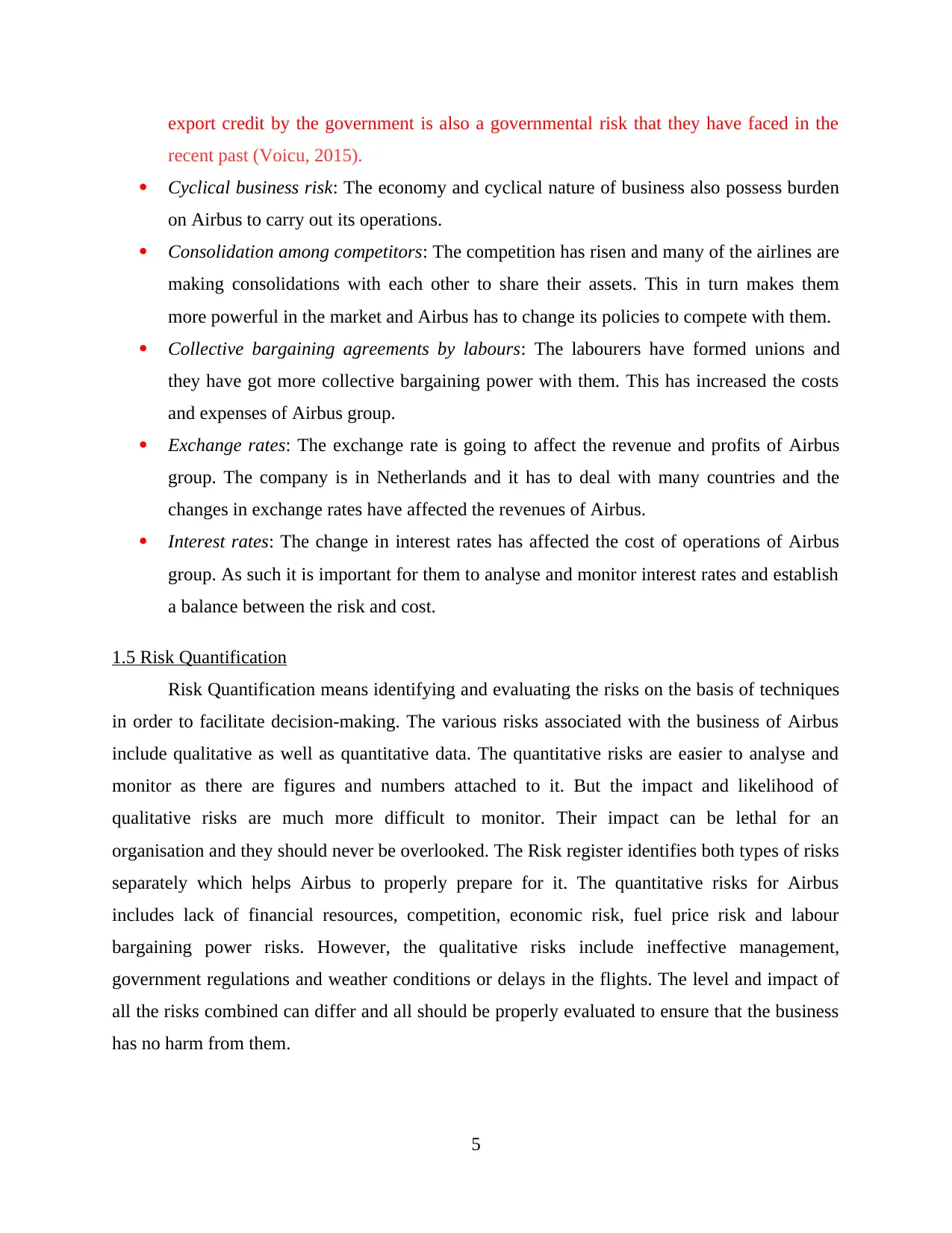
export credit by the government is also a governmental risk that they have faced in the
recent past (Voicu, 2015).
Cyclical business risk: The economy and cyclical nature of business also possess burden
on Airbus to carry out its operations.
Consolidation among competitors: The competition has risen and many of the airlines are
making consolidations with each other to share their assets. This in turn makes them
more powerful in the market and Airbus has to change its policies to compete with them.
Collective bargaining agreements by labours: The labourers have formed unions and
they have got more collective bargaining power with them. This has increased the costs
and expenses of Airbus group.
Exchange rates: The exchange rate is going to affect the revenue and profits of Airbus
group. The company is in Netherlands and it has to deal with many countries and the
changes in exchange rates have affected the revenues of Airbus.
Interest rates: The change in interest rates has affected the cost of operations of Airbus
group. As such it is important for them to analyse and monitor interest rates and establish
a balance between the risk and cost.
1.5 Risk Quantification
Risk Quantification means identifying and evaluating the risks on the basis of techniques
in order to facilitate decision-making. The various risks associated with the business of Airbus
include qualitative as well as quantitative data. The quantitative risks are easier to analyse and
monitor as there are figures and numbers attached to it. But the impact and likelihood of
qualitative risks are much more difficult to monitor. Their impact can be lethal for an
organisation and they should never be overlooked. The Risk register identifies both types of risks
separately which helps Airbus to properly prepare for it. The quantitative risks for Airbus
includes lack of financial resources, competition, economic risk, fuel price risk and labour
bargaining power risks. However, the qualitative risks include ineffective management,
government regulations and weather conditions or delays in the flights. The level and impact of
all the risks combined can differ and all should be properly evaluated to ensure that the business
has no harm from them.
5
recent past (Voicu, 2015).
Cyclical business risk: The economy and cyclical nature of business also possess burden
on Airbus to carry out its operations.
Consolidation among competitors: The competition has risen and many of the airlines are
making consolidations with each other to share their assets. This in turn makes them
more powerful in the market and Airbus has to change its policies to compete with them.
Collective bargaining agreements by labours: The labourers have formed unions and
they have got more collective bargaining power with them. This has increased the costs
and expenses of Airbus group.
Exchange rates: The exchange rate is going to affect the revenue and profits of Airbus
group. The company is in Netherlands and it has to deal with many countries and the
changes in exchange rates have affected the revenues of Airbus.
Interest rates: The change in interest rates has affected the cost of operations of Airbus
group. As such it is important for them to analyse and monitor interest rates and establish
a balance between the risk and cost.
1.5 Risk Quantification
Risk Quantification means identifying and evaluating the risks on the basis of techniques
in order to facilitate decision-making. The various risks associated with the business of Airbus
include qualitative as well as quantitative data. The quantitative risks are easier to analyse and
monitor as there are figures and numbers attached to it. But the impact and likelihood of
qualitative risks are much more difficult to monitor. Their impact can be lethal for an
organisation and they should never be overlooked. The Risk register identifies both types of risks
separately which helps Airbus to properly prepare for it. The quantitative risks for Airbus
includes lack of financial resources, competition, economic risk, fuel price risk and labour
bargaining power risks. However, the qualitative risks include ineffective management,
government regulations and weather conditions or delays in the flights. The level and impact of
all the risks combined can differ and all should be properly evaluated to ensure that the business
has no harm from them.
5
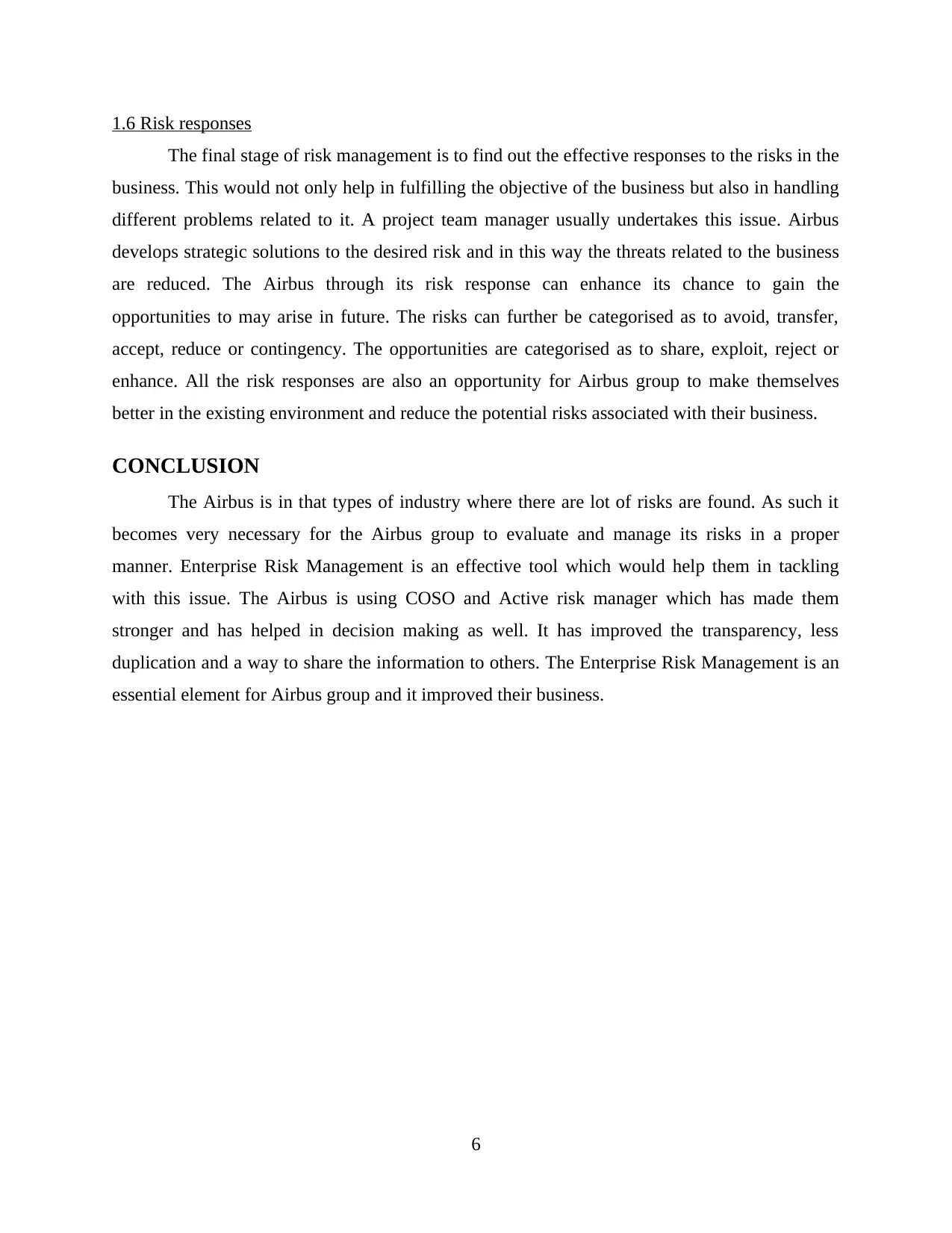
1.6 Risk responses
The final stage of risk management is to find out the effective responses to the risks in the
business. This would not only help in fulfilling the objective of the business but also in handling
different problems related to it. A project team manager usually undertakes this issue. Airbus
develops strategic solutions to the desired risk and in this way the threats related to the business
are reduced. The Airbus through its risk response can enhance its chance to gain the
opportunities to may arise in future. The risks can further be categorised as to avoid, transfer,
accept, reduce or contingency. The opportunities are categorised as to share, exploit, reject or
enhance. All the risk responses are also an opportunity for Airbus group to make themselves
better in the existing environment and reduce the potential risks associated with their business.
CONCLUSION
The Airbus is in that types of industry where there are lot of risks are found. As such it
becomes very necessary for the Airbus group to evaluate and manage its risks in a proper
manner. Enterprise Risk Management is an effective tool which would help them in tackling
with this issue. The Airbus is using COSO and Active risk manager which has made them
stronger and has helped in decision making as well. It has improved the transparency, less
duplication and a way to share the information to others. The Enterprise Risk Management is an
essential element for Airbus group and it improved their business.
6
The final stage of risk management is to find out the effective responses to the risks in the
business. This would not only help in fulfilling the objective of the business but also in handling
different problems related to it. A project team manager usually undertakes this issue. Airbus
develops strategic solutions to the desired risk and in this way the threats related to the business
are reduced. The Airbus through its risk response can enhance its chance to gain the
opportunities to may arise in future. The risks can further be categorised as to avoid, transfer,
accept, reduce or contingency. The opportunities are categorised as to share, exploit, reject or
enhance. All the risk responses are also an opportunity for Airbus group to make themselves
better in the existing environment and reduce the potential risks associated with their business.
CONCLUSION
The Airbus is in that types of industry where there are lot of risks are found. As such it
becomes very necessary for the Airbus group to evaluate and manage its risks in a proper
manner. Enterprise Risk Management is an effective tool which would help them in tackling
with this issue. The Airbus is using COSO and Active risk manager which has made them
stronger and has helped in decision making as well. It has improved the transparency, less
duplication and a way to share the information to others. The Enterprise Risk Management is an
essential element for Airbus group and it improved their business.
6
⊘ This is a preview!⊘
Do you want full access?
Subscribe today to unlock all pages.

Trusted by 1+ million students worldwide

REFERENCES
Books and Journals
Lam, J., 2014. Enterprise risk management: from incentives to controls. John Wiley & Sons.
Paape, L. and Speklè, R. F., 2012. The adoption and design of enterprise risk management
practices: An empirical study. European Accounting Review. 21(3). pp.533-564.
McNeil, A. J. and et.al., 2015. Quantitative risk management: Concepts, techniques and tools.
Princeton university press.
Gates, S. and et.al., 2012. Enterprise risk management: A process for enhanced management and
improved performance. Management accounting quarterly. 13(3). pp.28-38.
Caron, F. and et.al., 2013. A comprehensive investigation of the applicability of process mining
techniques for enterprise risk management. Computers in Industry. 64(4). pp.464-475.
Ai, J. and et.al., 2012. Enterprise risk management through strategic allocation of capital.
Journal of Risk and Insurance. 79(1). pp.29-56.
Mathur, C., 2014. Legal Aspects of Corporate Governance-Reflections from India. Available at
SSRN 2475724.
Allen, T. J., 2012. Guide to the Sally Bath-Prill Papers. 1934.
Lam, J., 2014. Enterprise risk management: from incentives to controls. John Wiley & Sons.
Voicu, I., 2015. Airbust?: setbacks bring the Airbus/Boeing subsidy dispute back into the
spotlight.
Online
Defining Risk management. 2016.
[Online] Available through: <http://pmtips.net/Blog/defining-risk-management-part-4-
risk-quantification>. [Accessed on 23 March 2016].
Risk Identification. 2014. [Online] Available through:
<http://www.ferma.eu/blog/2014/05/overview-aviation-risks/>. [Accessed on February
2016].
7
Books and Journals
Lam, J., 2014. Enterprise risk management: from incentives to controls. John Wiley & Sons.
Paape, L. and Speklè, R. F., 2012. The adoption and design of enterprise risk management
practices: An empirical study. European Accounting Review. 21(3). pp.533-564.
McNeil, A. J. and et.al., 2015. Quantitative risk management: Concepts, techniques and tools.
Princeton university press.
Gates, S. and et.al., 2012. Enterprise risk management: A process for enhanced management and
improved performance. Management accounting quarterly. 13(3). pp.28-38.
Caron, F. and et.al., 2013. A comprehensive investigation of the applicability of process mining
techniques for enterprise risk management. Computers in Industry. 64(4). pp.464-475.
Ai, J. and et.al., 2012. Enterprise risk management through strategic allocation of capital.
Journal of Risk and Insurance. 79(1). pp.29-56.
Mathur, C., 2014. Legal Aspects of Corporate Governance-Reflections from India. Available at
SSRN 2475724.
Allen, T. J., 2012. Guide to the Sally Bath-Prill Papers. 1934.
Lam, J., 2014. Enterprise risk management: from incentives to controls. John Wiley & Sons.
Voicu, I., 2015. Airbust?: setbacks bring the Airbus/Boeing subsidy dispute back into the
spotlight.
Online
Defining Risk management. 2016.
[Online] Available through: <http://pmtips.net/Blog/defining-risk-management-part-4-
risk-quantification>. [Accessed on 23 March 2016].
Risk Identification. 2014. [Online] Available through:
<http://www.ferma.eu/blog/2014/05/overview-aviation-risks/>. [Accessed on February
2016].
7
1 out of 10
Related Documents
Your All-in-One AI-Powered Toolkit for Academic Success.
+13062052269
info@desklib.com
Available 24*7 on WhatsApp / Email
![[object Object]](/_next/static/media/star-bottom.7253800d.svg)
Unlock your academic potential
Copyright © 2020–2025 A2Z Services. All Rights Reserved. Developed and managed by ZUCOL.





